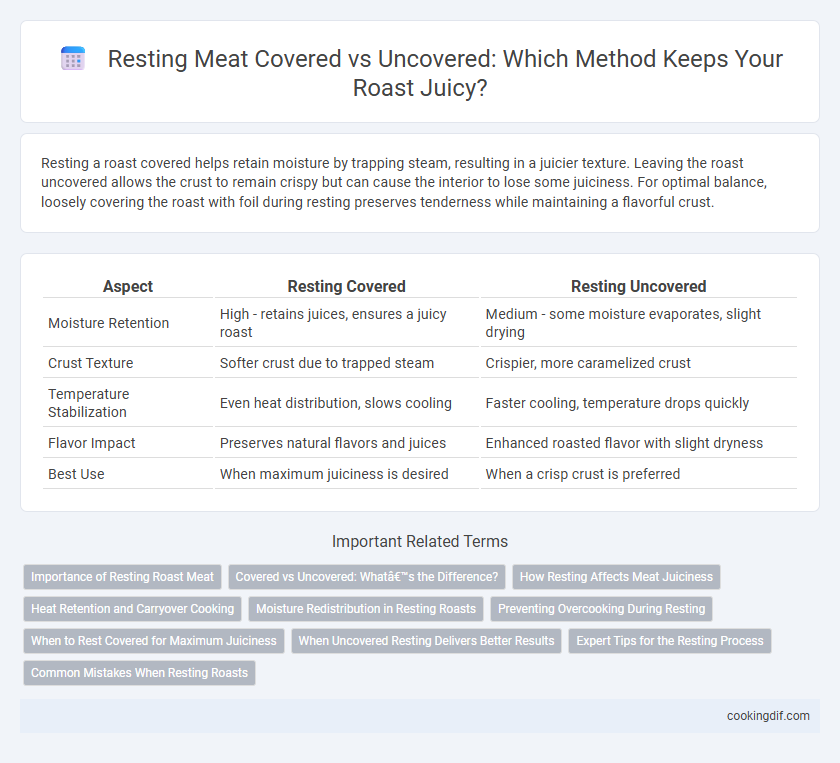Resting a roast covered helps retain moisture by trapping steam, resulting in a juicier texture. Leaving the roast uncovered allows the crust to remain crispy but can cause the interior to lose some juiciness. For optimal balance, loosely covering the roast with foil during resting preserves tenderness while maintaining a flavorful crust.
Table of Comparison
| Aspect | Resting Covered | Resting Uncovered |
|---|---|---|
| Moisture Retention | High - retains juices, ensures a juicy roast | Medium - some moisture evaporates, slight drying |
| Crust Texture | Softer crust due to trapped steam | Crispier, more caramelized crust |
| Temperature Stabilization | Even heat distribution, slows cooling | Faster cooling, temperature drops quickly |
| Flavor Impact | Preserves natural flavors and juices | Enhanced roasted flavor with slight dryness |
| Best Use | When maximum juiciness is desired | When a crisp crust is preferred |
Importance of Resting Roast Meat
Resting roast meat allows juices to redistribute evenly, ensuring a tender and flavorful result. Covering the meat with foil during resting helps retain heat and moisture, preventing drying out. Uncovered resting can form a crust but risks losing surface moisture, affecting juiciness.
Covered vs Uncovered: What’s the Difference?
Resting a roast covered traps moisture and heat, allowing the juices to redistribute evenly while keeping the surface tender and preventing drying out. Resting uncovered promotes a firmer crust by letting steam escape, which enhances texture but can result in slight moisture loss. Choosing covered or uncovered rest impacts juiciness and crust formation, with covered resting favoring moist, tender meat and uncovered enhancing caramelization and crust crispness.
How Resting Affects Meat Juiciness
Resting meat after roasting allows the juices to redistribute evenly throughout the muscle fibers, preventing excessive moisture loss when cut. Covering the roast with foil retains heat and moisture, enhancing juiciness by minimizing evaporation during the resting period. An uncovered roast cools faster, which can cause the surface to dry out but may develop a firmer crust, slightly reducing overall juiciness.
Heat Retention and Carryover Cooking
Resting a roast covered helps retain heat, maximizing carryover cooking and ensuring the interior reaches optimal temperature for juiciness. Leaving it uncovered allows surface moisture to evaporate, potentially resulting in a crisper crust but less heat retention and slightly reduced internal temperature rise. For the juiciest roast, covering during resting maintains warmth and moisture, enhancing succulence through continued cooking without drying out the exterior.
Moisture Redistribution in Resting Roasts
Resting a roast covered traps steam, which can soften the crust but may reduce moisture redistribution within the meat, leading to less even juiciness. Uncovered resting allows the roast's surface to cool and the internal juices to redistribute uniformly, enhancing overall moisture retention and tenderness. Optimal juiciness results from balancing moisture redistribution with crust texture by selecting the appropriate resting method.
Preventing Overcooking During Resting
Resting a roast uncovered allows steam to escape, preventing moisture buildup that can lead to overcooking through retained heat. Covering the roast traps moisture and heat, causing the internal temperature to rise further and potentially dry out the meat. To maintain a juicy roast, rest it uncovered on a warm plate or tent loosely with foil to balance heat retention and moisture evaporation.
When to Rest Covered for Maximum Juiciness
Resting a roast covered immediately after cooking traps steam and helps maintain moisture, creating a juicier result, especially for lean cuts like beef tenderloin or pork loin. Covered resting is most effective during the initial 10-15 minutes post-roast when the temperature is highest and evaporation risk is greatest. This method reduces moisture loss and enhances tenderness by allowing juices to redistribute evenly throughout the meat.
When Uncovered Resting Delivers Better Results
Resting a roast uncovered allows excess moisture to evaporate, creating a firmer, more flavorful crust while maintaining internal juiciness. This technique enhances Maillard reaction flavors by preventing steam buildup that can soften the roast's surface, resulting in a better-textured and more savory bite. Chefs often prefer uncovered resting when crispiness and concentrated taste are desired in beef or pork roasts.
Expert Tips for the Resting Process
Experts recommend resting a roast uncovered to allow excess moisture to evaporate, which helps achieve a crispy exterior while maintaining a juicy interior. Covering the roast traps steam, leading to a softer crust and potentially diluting flavor concentration. Optimal resting time ranges from 10 to 20 minutes, ensuring juices redistribute evenly throughout the meat for enhanced tenderness.
Common Mistakes When Resting Roasts
Resting a roast uncovered can cause excessive moisture loss, leading to a dry, less juicy result. Covering the roast traps steam, but common mistakes include leaving it tightly wrapped, which causes a soggy crust instead of a flavorful finish. Optimal resting involves loosely tenting the roast with foil to retain juiciness while allowing the crust to remain crisp.
Resting covered vs Uncovered for juicy roast Infographic

 cookingdif.com
cookingdif.com